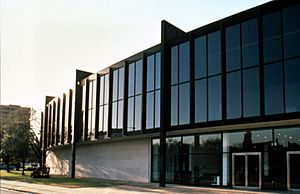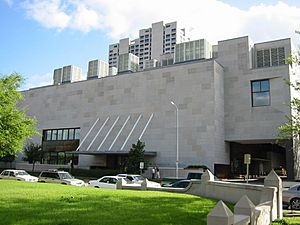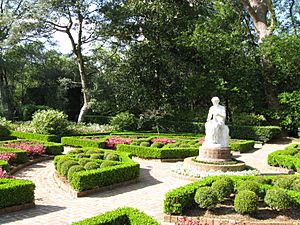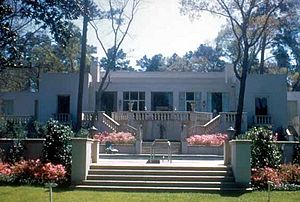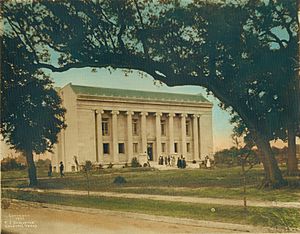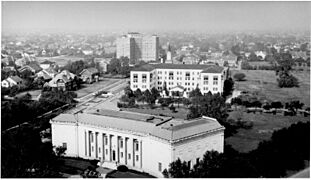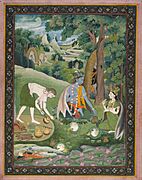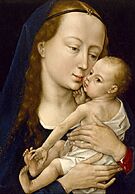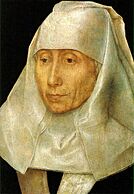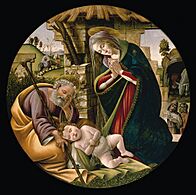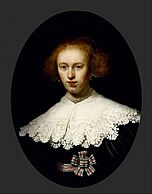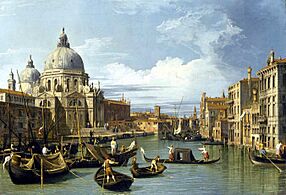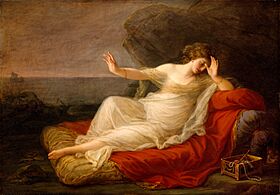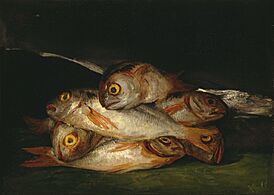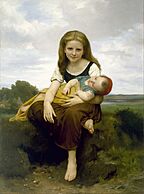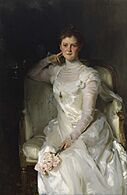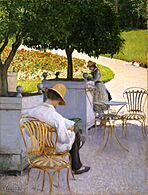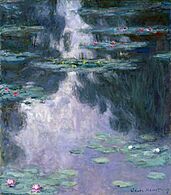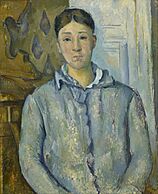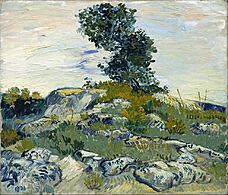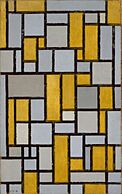Museum of Fine Arts, Houston facts for kids
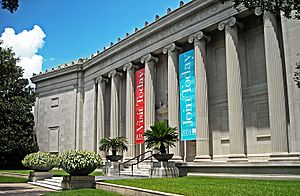
The Watkin Building is one of the museum's main buildings.
|
|
| Established | 1900 |
|---|---|
| Location | 1001 Bissonnet Houston, TX 77005 United States |
| Type | Art museum, institute, library, sculpture park |
| Public transit access |
Red Line
Museum District |
The Museum of Fine Arts, Houston (MFAH) is a very large art museum in Houston, Texas. It is located in the city's Houston Museum District. The museum's collection has nearly 80,000 works of art from six continents, covering over 5,000 years of human history.
The MFAH is one of the biggest art museums in the Americas. In 2020, it opened the new Nancy and Rich Kinder Building after an eight-year project to expand its campus. With so much to see, the museum is very popular. In 2023, it was the 20th most-visited museum in the United States, with over 900,000 visitors.
Contents
The Museum Campus
The MFAH is so big that its collection is spread across nine different buildings. The main area, called The Susan and Fayez S. Sarofim Campus, covers 14 acres. It includes the main art buildings, a sculpture garden, and an art school. Two other museum buildings, called Bayou Bend and Rienzi, are located in different parts of Houston.
Main Art Buildings
- Caroline Wiess Law Building – This was the museum's first building, built in 1924. It has a classic style with large columns. Over the years, famous architect Ludwig Mies van der Rohe designed additions to the building. Today, it shows art from Asia, Africa, and the Pacific Islands. It also holds the world's largest collection of African gold.
- Audrey Jones Beck Building – This modern building opened in 2000. It was named for Audrey Jones Beck, who donated her amazing collection of art to the museum. Here, you can see ancient art from places like Egypt and Rome. It also features European and American art, including famous Impressionist paintings.
- Nancy and Rich Kinder Building – Opened in 2020, this is the newest building. It was designed by architect Steven Holl. It focuses on modern and contemporary art made after 1900. The building added a lot more gallery space to the museum. It also has a movie theater, restaurants, and seven small gardens.
Gardens and Schools
- The Lillie and Hugh Roy Cullen Sculpture Garden – This peaceful outdoor space was designed by artist Isamu Noguchi and opened in 1986. You can walk through the garden and see more than 25 sculptures by famous artists from the last three centuries.
- Glassell School of Art – This school is for people of all ages who want to learn how to make art. The current building, designed by Steven Holl, opened in 2014. It has a sloped roof that works as an amphitheater and a rooftop garden. The school offers classes and workshops for kids and adults.
- Central Administration and Glassell Junior School of Art Building – This building houses the museum's offices and a special art school just for children. The MFAH is the only museum in the U.S. with a separate building for kids' art classes.
House Museums
- Bayou Bend Collection and Gardens – This was once the home of a Houston resident named Ima Hogg. In 1957, she gave her home and its 14 acres of gardens to the museum. The house is filled with American furniture and decorative art from the 1600s to the mid-1800s.
- Rienzi – This is another house museum, but it displays European decorative arts. The home was given to the museum in 1991. It is surrounded by beautiful gardens in the River Oaks neighborhood.
History of the Museum
The Museum of Fine Arts, Houston is the oldest art museum in Texas. It started in 1917 when the Houston Public School Art League decided to create a public museum. The first building opened its doors in 1924.
In the early years, the museum's collection grew thanks to generous people. George M. Dickson gave the first important paintings. A woman named Ima Hogg, who also donated the Bayou Bend estate, gave the museum many important artworks, including Native American art.
Over the decades, many families and foundations in Houston donated art and money. This helped the museum collect art from all over the world, including European paintings, African art, and modern sculptures. By 1970, the museum had 12,000 objects.
The collection grew even more between 1970 and 1989. John and Audrey Jones Beck loaned the museum 50 masterpieces of Impressionist and Post-Impressionist art. These paintings were later gifted to the museum and are now a main attraction. The museum also started collecting photography during this time.
Today, the MFAH is known for having a diverse collection that represents many different cultures. It has a special center for researching Latin American art and often shows works by African American artists that explore themes of history and identity.
The Art Collection

The MFAH has about 70,000 works of art. The collection is so varied that it's like taking a trip through art history. Some of its strongest areas include:
- Italian Renaissance painting
- French Impressionism
- Photography
- American and European decorative arts
- Gold objects from Africa and ancient America
- Art from after 1945
The museum is also building its collections of Latin American, Asian, and Islamic art. This wide range of art makes the MFAH one of the most popular museums in the country.
Disagreement Over a Painting
In 2021, a group called the Monuments Men Foundation said that a painting in the museum, The Marketplace at Pirna by Bernardo Bellotto, had once belonged to a man named Max Emden. They believed the painting had been sold unfairly during the Nazi era in Germany.
The family of Max Emden asked the museum to return the painting. The museum disagreed, stating that Emden had sold the painting by choice and not because he was forced to. After a legal case, the U.S. courts ruled in favor of the museum in May 2024, and the painting remains at the MFAH.
Galleries
Arts of Africa, the Indigenous Pacific Islands, Australia, and the Americas
Arts of Asia and the Islamic Worlds
European and American painting (1400–1899)
-
Fra Angelico, Saint Anthony Abbot Shunning the Mass of Gold (c. 1435–1440)
-
Rogier van der Weyden, Virgin and Child (after 1454)
-
Hans Memling, Portrait of an Old Woman (c. 1468–1470)
-
Rembrandt van Rijn, Portrait of a Young Woman (1633)
-
Matthias Stom, The Judgement of Solomon, (c. 1640)
-
Canaletto, Entrance to the Grand Canal, Venice (c. 1730)
-
Angelica Kauffmann, Ariadne Abandoned by Theseus (1774)
-
Jean-Baptiste-Camille Corot, Orpheus Leading Eurydice from the Underworld (1861)
-
William-Adolphe Bouguereau, The Elder Sister (1869)
-
John Singer Sargent, Mrs. Sarah Montgomery Sears (1899)
Impressionism, postimpressionism, and early modern art
-
Pierre-Auguste Renoir, Still Life with Bouquet (1871)
-
Gustave Caillebotte, The Orange Trees (1878)
-
Claude Monet, Water Lilies (Nympheas) (1907)
-
Paul Cézanne, Madame Cézanne in Blue (1888–1890)
-
Vincent van Gogh, The Rocks (1888)
-
Piet Mondrian, Composition with Grid No. 1 (1918)
See also
 In Spanish: Museo de Bellas Artes (Houston) para niños
In Spanish: Museo de Bellas Artes (Houston) para niños
- Bayou Bend Collection and Gardens
- Ima Hogg
- Samuel Henry Kress
- List of largest art museums
- List of most-visited museums in the United States
- List of claims for restitution for Nazi-looted art


